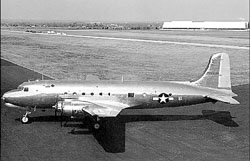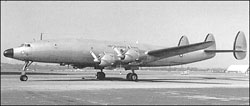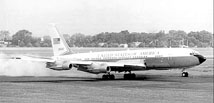|
Air
Force One
by Laurie
Lips
JANUARY 2001
In 1936, the first special
missions and VIP transports began flying out of Bolling Air
Force Base, Washington D.C.
The first aircraft designated
specifically for presidential use was a C-87A Liberator Express,
an adaptation of the B-24 Liberator bomber, which had the serial
number of 40-24159.
Most C-87s were assigned
to the Air Transport Command. The aircraft was nicknamed the
"flying coffin" by Air Corps pilots, due to fuel transfer innovations
by Consolidated.
Only six C-87A's, the VIP
version of the C-87, were built; three went to the Navy and
three to the United States Army Air Force staff squadrons at
Bolling Air Force Base, to shuttle VIPs back and forth.
The presidential C-87A was
named "Guess Where 2." Although First Lady Eleanor Roosevelt
flew aboard her for a trip to South and Central America, her
famous husband, President Franklin D. Roosevelt, did not fly
with her. In 1945, Guess Where 2 was scrapped in Arkansas.
On January 11, 1943, "FDR"
made the first flight by a president in office in a trip made
via seaplane and landplane. The purpose of the flight was to
attend the Casablanca Conference with Winston Churchill, regarding
plans for the European invasion.
After taking the presidential
rail car, the "Ferdinand Magellan," from Washington D.C. to
Miami, he boarded a Boeing 314 Clipper, a long-range, four-engine
flying boat used for trans-Atlantic flights before World War
II. For the president's comfort, a double bed was added to the
plane. Once in Bathurst, he boarded a Douglas C-54 Skymaster
(a military counterpart of what would have been the civilian
DC-4, but the military procured the entire line). The plane
took him on to Casablanca.
After this trip, the army
contracted with Douglas for a special version of the Skymaster,
a C-54C with a serial number of 42-107451, which was delivered
in 1944. Since he had never flown in the Guess Where 2, the
plane, nicknamed the "Sacred Cow" by the White House press corps,
is considered the first presidential aircraft. (An elevator
was used to lift FDR into and out of the plane.)

FDR, however, didn't like to fly. He preferred travel by ship
or train. In February 1945, FDR traveled to the USSR for a conference
with Churchill and Stalin. Part of this trip, from Malta to
Saki, and returning, from Saki to Cairo, was made aboard the
Sacred Cow.
Present Harry S. Truman
loved to fly, and used the Sacred Cow often. One of Truman's
most memorable flights is when he had his pilot buzz the White
House twice before heading to Kansas City.
The pilot was nervous, saying
that he would most likely catch a lot of hell over that action,
but Truman said he had "broad shoulders" and the Sacred Cow
went on a full power dive directly toward the White House. They
pulled up at 500 feet. The president then "ordered" the pilot
to do it again. His wife and daughter, spectators on the rooftop
of the White House watching a display of the new P-80 "Shooting
Star" jets, watched as the "Sacred Cow" shot through the skies
over Washington.
Visitors who used the plane
included Winston Churchill, General George C. Marshall, and
China's Chiang Kai-Shek.
The Sacred Cow was the birthplace
of the U.S. Air Force as Truman signed the National Security
Act of 1947 (an act that established the Defense Department
and created the U.S. Air Force as an independent service) on
board the aircraft on July 26, 1947.
In 1961, after the Sacred
Cow was set out to pasture, it became the property of the Smithsonian
Museum of Flight, who later loaned it to the U.S. Air Force
Museum at Wright-Patterson Air Force Base, Dayton, Ohio, where
it is now on display.
The Sacred Cow was replaced
by a VC-118 (Douglas DC-6B), which was commissioned on July
4, 1947. This plane was named "Independence," after Truman's
hometown.

The paint scheme on the plane including a motif of an eagle,
which encompassed most of the fuselage.
Truman's first trip abroad
in the plane was made to Rio de Janeiro, in September 1947,
to discuss the Korean War with General Douglas McArthur.
The Air Force, trying to
contemplate the upcoming election in 1948 and wanting to impress
the new president, took liberties to order ten Lockheed Constellations,
modifying one of them, serial number 48-608, and earmarking
it for Tom Dewey, whom Air Force "experts" predicted would win
the presidential race. The unofficial name of this plane was
"Dewdrop"; one could imagine the embarrassment it caused when
Truman was reelected. The Dewdrop never flew as Air Force One.
In October 1948, the 1254th
Air Transport Wing, responsible for providing safe and reliable
worldwide airlift and logistical support for the president,
vice president, cabinet members and other high-ranking U.S.
and foreign government officials, was established at Washington
National Airport. From that year through 1961, VIP flights and
special missions would fly out of this airport.
President Dwight Eisenhower,
who took office in 1952, rejected the Independence as his presidential
aircraft. It flew once more as the presidential aircraft on
a flight from Washington DC to New York City in 1961; the president
on board was President Kennedy. The airplane has been restored
and, since August 1965, has been on display at the Air Force
Museum at Wright-Patterson AFB, Dayton, Ohio.
"Ike" chose to use a Constellation,
designed by Lockheed. The Constellation (C-69), which was designed
in part by Howard Hughes for TWA, was the heaviest and fastest
transport at the time. As Supreme Commander of the Allied Forces,
the then General Eisenhower used this type of aircraft as his
personal airplane. Eisenhower, whose great love for his wife
Mamie is still remembered today, named the aircraft he used
when he was a general the "Columbine I," after the state flower
of Colorado, her adopted home state. After its retirement, this
plane was restored. After being displayed for a time at Pima
Air Museum, Tucson, Ariz., it can now be found at the Santa
Fe International Airport.
After becoming president,
Ike flew in a C-121A (serial number 48-610), named the "Columbine
II." The Columbine II was the first presidential aircraft to
use the call sign "Air Force One." This special call sign came
as a result of some frightening confusion; an Eastern Airlines
passenger flight using its flight number "8610" as a radio call
sign was in the same area as the president's plane, which at
that time was using the Air Force call sign of 8610. This created
a need to create a unique call sign for the presidential aircraft.
Any aircraft can be "Air Force One"; the designation means that
the president is on board. The Columbine II was later scrapped
at Davis Monthan Air Force Base, Arizona.
A Lockheed C-121E (Super
Constellation) was christened by Mamie Eisenhower in 1954 as
"Columbine III," and was Ike's favorite business plane. This
aircraft has been restored and is on display at the Air Force
Museum, Dayton, Ohio.

"Ike" also used a smaller aircraft, a U4-B (L-26 Aero Commander)
between 1956 and 1960, for short distances, often flying it
himself. It was the first presidential aircraft to carry the
familiar blue and white paint scheme.
(See "Ike's Aero Commander,"
which precedes this story)
After Soviet leaders began
showing up at International conferences in jets in the late
1950s, Ike soon inherited a VC-137B (Boeing 707-120). This "off
the shelf" jet was one of three that were purchased, which became
SAM (Special Air Mission) 86970, 86971, and 89672.
In August 1959, Ike arrived
in style aboard SAM 86970 on a historic trip to meet with Germany's
then Chancellor Konrad Adenauer. That same year, in an 11-day
period, Ike visited 11 countries aboard the aircraft. This VIP
transport, capable of accommodating 58 passengers, featured
special communications systems and a flying "Oval Office."

SAM 86970 retired in 1996, and took up residence at Boeing's
Museum of Flight, Seattle, Wash.
In 1961, the 1254th Air
Transport Wing, transferred from Washington National Airport
to Andrews Air Force Base, located less than 20 miles southeast
of Washington, D.C. Also that year, the "V" designation was
added to model numbers to show that they were presidential aircraft.
During Senator John F. Kennedy's
successful presidential campaign in 1960, his primary mode of
transportation was a Convair 240 named "Caroline," after his
daughter, which his father purchased for him. The Kennedy family
donated "Caroline" to the National Air and Space Museum in November
1967.
After becoming president,
Kennedy first flew aboard a C-118 (DC-6, with serial number
3240) During this time, "Air Force One" became more broadly
known. The C-118 is now on display at the Pima Air Force Museum,
Tucson, Ariz.
Kennedy used the C-118 to
make local trips. He flew in SAM 89670, which continued its
service through the Nixon administration, to Ireland and Germany
(Where he made his famous speech at the Berlin Wall). It was
not officially decommissioned until 1996; it is now on display
at the Museum of Flight in Seattle.
In October 1962, a VC-137C
(Boeing 707-320B) specifically purchased for use as Air Force
One, entered service as SAM 26000.
SAM 26000, which served
seven presidents for nearly 30 years, is perhaps the most widely
known presidential aircraft.

In November 1962, Kennedy flew aboard SAM 26000 to attend the
funeral of former first lady Eleanor Roosevelt, in New York.
During Kennedy's administration,
"Air Force One" received its blue and white paint scheme, and
the words "United States of America" were proudly painted on
both sides of the fuselage. The patriotic plane also bore the
Presidential seal on both sides of the nose and the U.S. flag
on the vertical stabilizer.
On Nov. 22, 1963, a date
stamped on the memories of many, President Kennedy flew the
jet into Love Field in Dallas, Texas. Later that day, the jet's
pilot, Col. James Swindal would receive the word that Kennedy
had been shot, and would prepare for departure. Vice President
Johnson was rushed aboard, where he waited until Kennedy's grieving
widow Jacqueline and the casket in which the beloved president's
body lay, arrived. For the task of getting his casket on board,
the bulkhead near the entrance and two rows of seats were removed.
As presidential aides and
Mrs. Kennedy watched, Federal Judge Sara Hughes administered
the oath of office to LBJ, before the jet departed Love Field
with Mrs. Kennedy, the body of her husband, his aides, and President
Johnson and Lady Bird Johnson on board, to return to Washington
D.C. When the plane got back to Andrews that evening, the air
terminal was jammed with thousands of people, including media
representatives and those there to mourn the loss of Kennedy.
Later, this same jet would
do a fly-bye and at 1,000 feet, dip its wings in a final salute
above Arlington Cemetery to the president it had served.
Along with other changes,
President Johnson had the seats rearranged (passengers now faced
the rear of the jet) in the SAM 26000 and added a large kidney-shaped
desk and a large swivel chair. The secret service and crew referred
to this chair as "the throne." LBJ would make trips to Vietnam
and to Texas in SAM 26000.
After Nixon's inauguration,
LBJ got permission to return to Texas in the jet. All of the
china, silverware, napkins, towels, the throne, and the desk
were stripped from the aircraft to become part of the "LBJ Library."
LBJ's final ride in the
SAM 26000 was when his body was transported from his state funeral
in Washington DC to Austin, Texas, where his body was transported
to the Johnson Ranch for internment. SAM 26000 has been on display
at the Air Force Museum at Wright-Patterson Air Force Base,
Dayton, Ohio, since 1998.
In January 1966, the 1254th
Air Transport Wing was discontinued. Air Force One became the
responsibility of the 89th Military Airlift Wing Special Missions.
(After several name and organizational changes the 89th Airlift
Wing was formed in 1991. The airlift wing is an Air Mobility
Command asset directly assigned to 21st Air Force, headquartered
at McGuire AFB, N.J.)
SAM 26000 was taken to the
Boeing Factory for a complete overhaul shortly after President
Nixon traveled in it to Vietnam in February 1969.
It was finished in time
for Nixon's 13 day round-the-world flight in July 1969, at which
time, Nixon gave the plane it's official name, "The Spirit of
'76".
Nixon made trips to the
Republic of China and Russia aboard the jet in 1972. In December
of that same year, SAM 27000, another Boeing 707 (serial number
27000) bumped SAM 26000, becoming "Air Force One." Although
the Nixon family still often flew in 26000, Nixon eventually
transferred the name, "The Spirit of '76," to the newer jet.
SAM 26000, however, hadn't
outlived its usefulness. It was used to carry Dr. Henry Kissinger,
and Presidents Nixon, Ford and Carter to the funeral of Egyptian
President Anwar Sadat in 1981. It wasn't retired from service
until 1998, when it was placed on display at the Air Force Museum
at Wright-Patterson AFB.
After some bumps in his
political career, on Aug. 9, 1974, Nixon flew through the skies.
He started the trip aboard "Air Force One" as president. After
officially "resigning," he ended the trip to California as an
ex-president, flying aboard "SAM 27000." The call sign had been
changed during the flight. The jet would later fly as Air Force
One again, but for the time, there was no president on board.
SAM 27000 had a prestigious
career; she carried more presidents then any presidential aircraft
before her had carried. Her precious "cargo" included Presidents
Ford, Carter, Reagan, and George Bush Sr.
Today, the 89th Wing's Presidential
Pilots Office operates and maintains two VC-25As (modified Boeing
747-200B Jumbo Jets), which are SAM 28000 and 29000. This jet,
which has as cruising speed of 600 mph, won out over the DC-10
in 1990, to replace SAM 27000.
SAM 27000 is still in the
SAM inventory. She has flown under the designation of "Air Force
II," which means that the vice president is aboard. Her days
are however, numbered; she is expected to face retirement in
2002.
SAM 28000, the largest presidential
aircraft to date, was received at Andrews AFB in August 1990.
President Bush flew SAM 28000 on her first presidential flights
on September 6, 1990 to Topeka, Kansas, and Tallahassee, Florida.
The next day he flew aboard her to Helsinki, Finland.
SAM 29000 arrived shortly
after.
SAM 28000 and 29000 can
carry 70 passengers and 23 crewmembers, and are specially equipped
to meet the president's needs. Each has 4,000 square feet of
interior floor space, an executive suite consisting of a stateroom
and office, a conference/dining room, and a passenger cabin.
Nancy Reagan is credited for having planned the interior design
and overseeing colors and fabrics. Rumor has it that everyone
who steps onboard Air Force One has to slip on cloth "booties"
to keep the wall-to-wall carpet clean.
Each has secure global communications
and inflight refueling capabilities. The aircraft also has a
medical dispensary with an operating table, and is outfitted
with mission-related equipment and enough food for up to 2,000
meals. Two galleys on board are capable of providing food for
50 people each.
The global communications
system on board, maintained and protected by 238 miles of wire,
shielded for protection again electromagnetic pulse, includes
copiers, computers, fax machines, televisions, videocassette
recorders, 85 telephones, as well as multi-frequency radios
for satellite, air-to-ground, and air-to-air communications.
The jets are also modified for aerial refueling, and are virtually
unlimited in range.
Air Force One is housed
in a 140,000-square-foot maintenance and support complex at
Andrews Air Force Base. The 89th Wing's presidential support
unit includes more than 160 pilots, flight engineers, flight
attendants, communications operators, navigators, information
managers, and others who maintain the aircraft, handle security,
and support flight operations. Ten of the 26 crewmembers on
each mission are flight attendants.
There are nine former presidential
aircraft at the Air Force Museum at Wright Patterson, including
a UH-13J (the Air Force's version of the Bell commercial model
47J Ranger helicopter, a North American T-39A (Sabreliner),
a Lockheed VC-140B Jetstar (military version of the Lockheed
Model 1329 light jet transport), and a Beech VC-6A (Beech King
Air B90).
The Beech VC-6A was used
locally to transport President Johnson and members of his family
from Austin to the Johnson ranch. This plane, called the "Lady
Bird Special," has been on display at the Museum, since 1985.
Besides the Boeing 747s,
the SAM inventory now includes four C-32As (Boeing 757s), three
C-9Cs (Douglas DC-9s), five C-20Bs (Gulfstream IIs), two C-20Hs
(Gulfstream IVs), two C-37As (Gulfstream Vs), and 19 UH-1N helicopters.
|



